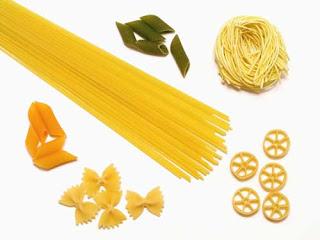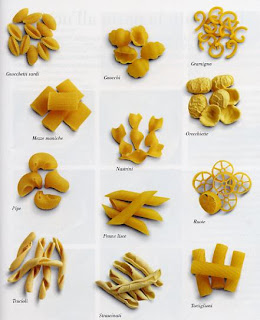Pasta | Pasta is unleavened dough, made of wheat flour, water, and sometimes eggs, that is molded into any of a variety of shapes and boiled. Pastas are products made essentially from milled cereals and water. In the West, good quality pasta is made from a hard wheat variety, durum wheat, which has a high protein (and thus gluten) content and is low in starch. It can also be made from soft wheat flour, a mixture of hard and soft wheat, buckwheat flour, rice flour or, less often, corn flour. Small quantities of soy or mung bean flour, vegetables (spinach, tomatoes, beets, carrots), gluten, whey, eggs, flavors, fresh herbs, spices and colors can be added. Some pasta can be colored using a coloring agent rather than a vegetable purée. "Egg" pasta is made with soft wheat flour. In some countries, pasta is enriched with B-complex vitamins (thiamine, riboflavin and niacin) and sometimes iron. Protein and fiber-enriched pastas are also available.
Any of several starchy food pastes (pasta alimentaria) made from semolina, the purified middlings (endosperm) of a hard wheat called durum. Pasta is traditionally associated with Italian cuisine, though it may have entered Europe from Asia during the Mongol invasions of the 13th century. In making pasta, semolina dough is rolled out and sliced or compacted and forced through perforated plates (dies) that form it into the desired shape. It is produced in the form of sheets, ribbons, cords, tubes, and other shapes, each with its own name (e.g., spaghetti, macaroni). The formed dough is then dried under controlled conditions. Pasta is boiled and topped with a sauce or combined with other foods before serving.
Pasta is a universally enjoyed food, and almost every country serves a type of noodle. In China, it is mein; Japan, udon; Poland, pierogi; Germany, spaetzle. The popularity of pasta can be attributed to several factors: it is easily manufactured, it takes up little storage space, it is easy to cook, and it is rich in complex carbohydrates.
Ancient Etruscan meals of gruel and porridge were eventually replaced with more appetizing unleavened bread cakes. Food historians believe these cakes may have been the precursor to pasta. Opinions about where the noodle originated vary. The Italian explorer Marco Polo has been commonly credited with bringing the noodle back to Italy from his travels in the Orient during the 1300s. However, some contend that a close examination of Polo's papers reveals that he reported enjoying a certain type of noodle in China, comparing it favorably to the pasta he was accustomed to eating in Italy.
Nevertheless, it is true that Chinese noodles have been around for centuries. The vermicelli-like transparent noodles are made from the paste of germinated mung beans and are usually soaked in water before they are boiled or fried. (Pasta has not always been prepared by boiling. In fact, boiled noodles were once considered a relatively bland meal. Frying or grilling were the preferred preparations.) Koreans claim to have taught the Japanese how to make soba noodles in the 12th century, using Chinese buckwheat grown in the northern regions where rice paddies could not survive.
Early French writers also mention a dish called pastillum, essentially a ravioli-like pouch filled with meat. However, the Italians have staked the claim so vehemently that today we generally think of pasta dishes as Italian in origin. In fact, the word "pasta" comes from the Italian phrase "paste (dough) alimentari (relating to nourishment)."
The first industrial production of pasta occurred in Naples in the early 15th century. The site was chosen for its naturally fluctuating temperatures, sometimes as much as four times a day, which provided the hot and cold temperatures necessary for drying. Mechanical drying was not invented until 1800.
Pasta is made from a mixture of water and semolina flour. Semolina is a coarse-ground flour from the heart, or endosperm, of durum wheat, an amber-colored high protein hard wheat that is grown specifically for the manufacture of pasta. With a lower starch content and a higher protein content than all-purpose flours, semolina flour is easily digested. Farina, rougher granulations of other high-quality hard wheat, is also used to make some pastas. The semolina and farina flour are enriched with B-vitamins and iron before they are shipped to pasta plants.
Eggs are sometimes added to the mixture for color or richness. Federal guidelines stipulate that egg noodles contain a minimum of 5.5% egg solids. Vegetable juices, such as spinach, beet, tomato, and carrot, can also be added for color and taste. In recent years, the addition of herbs and spices such as garlic, basil, and thyme has become popular.
How to Buy Pasta
Choose: unbroken pasta with a smooth and regular appearance, evenly colored, or ivory verging on yellow. Fresh pasta should have a pleasant smell.
How to Serving Pasta
Pasta accompanies meat, poultry and seafood. In Asia, pasta is enjoyed roasted. Dishes served with pasta are usually based on tomato, to which ground meat, seafood, cheese, poultry, vegetables or ham is added. Pastas can be stuffed with ground meat, spinach, cheeses, fresh herbs or mushrooms.
How to reduce calories:
- Replace cream-based sauces with ones based on vegetables or fresh herbs.
- Replace cream with skim milk.
- Use low-fat cheeses (cottage cheese, ricotta) and reduce the amount of high-fat cheeses (for gratins).
- Reduce the amount of meat used in the sauces and choose poultry instead.
- Replace butter with olive oil.
How to Storing
Pasta
- At room temperature: keep dried bought pasta indefinitely in a dry place, protected from drafts.
- In the fridge: fresh pasta, covered, 1-2 days; cooked pasta, 3-5 days; fresh egg pasta and stuffed pasta, 1 day.
- In the freezer: 2 months, fresh pasta and cooked pasta; fresh egg pasta and stuffed pasta.
How to Storing
Cook Pasta
Boiled: pour small pasta in a stream, or push long pasta gradually into the water as it softens. Add pastas to water that is already at a full boil to obtain Italian-style pasta cooked al dente (pasta that is still firm to the bite without tasting uncooked). The cooking water should be salted (1 tablespoon/15 ml of salt for 1 lb (500 g) of fresh or dried pasta). A small amount of oil can be added to prevent the pasta sticking together and some professional cooks believe that this also prevents the water from boiling over. Stir pasta gently as it softens. A large pot should be used so that the pasta can be cooked at a full boil (as pasta swell) and cooked evenly. Use about 2 quarts (3 l) of water for 1 lb (500 g) of pasta, and 1 more quart for every extra 1/2 lb (250 g) of fresh or dried pasta.
The cooking time is a matter of taste, but also depends on the quantity of pasta, its size and the hardness of the water. For al dente pasta, it is best to taste pasta during cooking so that it can be stopped at the right time.
The cooking time also varies depending on the moisture content of the pasta.
- Hard wheat pasta takes longer to cook than soft wheat pasta.
- Fresh pasta cooks more quickly than dried pasta.
- Pasta that will be cooked a second time or frozen should be cooked for a shorter time.
- Drain the pasta as soon as the cooking is finished.
- Once cooked, pasta should not be rinsed in cold water unless it is high in starch (soft wheat pasta, for example), to stop it from sticking, or if one wants to cool it down immediately (to make into a salad) or stop the cooking process (for dishes that require a second cooking process).
Some pastas can be used without being precooked, in dishes cooked in the oven (lasagna, manicotti, cannelloni, etc.), where
it is a matter of increasing the amount of liquid or sauce.
Pasta's Nutritional Facts
Despite its reputation for being high in calories, it is not pasta itself that is high in calories, but rather what is added to it (butter, cream and cheese). Its nutritional value varies depending on what its ingredients are (whole grains, eggs, milk powder, vegetables) and the amount of cooking. Pasta that is cooked for a long time contains slightly fewer B-complex vitamins than firm pasta. Pasta is a good source of energy and protein, and it is low in fat. Its high level of carbohydrate is mostly in the form of complex carbohydrates (which are easy to digest and are absorbed more slowly by the body). This is why pasta is recommended for people who need sustained energy.
Tags: pasta storage containers, pasta basket, pasta gifts, chicken parmesan pasta, pasta packaging, pasta baskets, olive oil pasta, diabetic pasta recipes, pasta catering, pasta and diabetes, broders pasta bar, diabetic pasta, chicken spinach pasta, dreamfields pasta diabetes, chicken florentine pasta, pasta for diabetics, pasta gift basket, pasta gift baskets, loring pasta bar, pasta bowl chicago








Grains as wheat are more useful eatables with which we could make many good recipes. These grains can be produced more by urea n46 prilled
ReplyDeletegood... can i copy for my blog too?? please give me permits... because i love pasta. tks before
ReplyDeletethere have been plenty of pasta recipe, wonderful sharing
ReplyDeletePearson Airport Taxi
nice post. Very informative.
ReplyDeleteWow! Its really very tasty blog :) :P
ReplyDeleteMiami Vending Machines